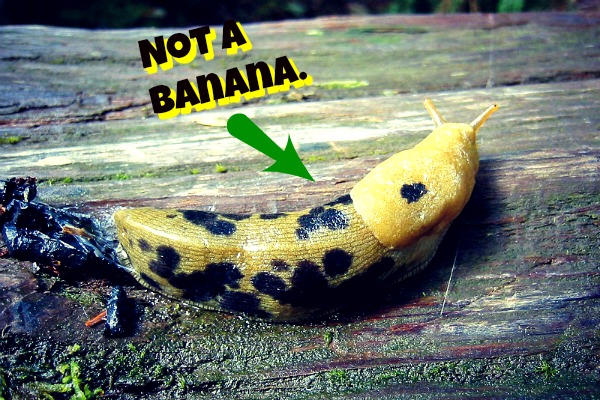Prepare to feel a little queasy next time you see a banana. As if slugs weren’t shudder-inducing already, there is a slug that actually resembles a banana. Seriously.
Despite its unappetizing exterior, the banana slug is actually an amazing little creature. Usually found in forested areas of the pacific coast, the banana slug is a integral part of the ecosystem in which it lives. Banana slugs are avid recyclers, chomping on materials that are found on the forest floor- leaves, dead plants, mushrooms, animal poop- and leaves behind the digested remains as a nutrient-rich soil called humus. SCIENCE!
Let’s learn some more fun facts about banana slugs, eh?
-
Like other land slugs, banana slugs are simultaneous hermaphrodites, meaning they have both male and female genitalia. Post-coitus, one banana slug will chew the penis off of the other, rendering them unable to mate again.
-
Banana slugs have a coating of mucus over their bodies which tastes horrible to predators. To counteract this, raccoons will roll the banana slug in soil to create a panko crust of debris. Bon appetit!
-
The banana slug is the second largest slug in the world, measuring up to 9.8 inches in length. For perspective, an average-sized banana is 7 to 8 inches.
-
Two sets of feelers adorn the banana slug’s head: one set can sense light and motion, the other senses chemicals and smells.
-
If a banana slug loses a feeler, a fresh new one will grow in its place.
-
The color of a banana slug can change depending on its diet, light exposure, and the amount of moisture in their environment. The colors range from yellow, to yellow with black spots (like a ripe banana!), and more rarely- green and white.
-
When banana slugs mate, they form their squishy bodies into the shape of a heart.
-
The banana slug is the unofficial mascot of the University of California-Santa Cruz.
-
If a banana slug wants to get down from a tree, it suspends itself from a thin string of its mucus to slowly descend from a branch, like a slimy lethargic spider.
-
A banana slug’s penis length can be as long as their body. In fact, their Latin name is dolichophallus, which means ‘giant penis’. Remember Fun Fact #3? That’s a well-endowed little gastropod.





